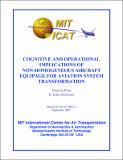| dc.description.abstract | The air traffic management system is currently experiencing a significant
transformation to provide better quality service and to match the increasing air traffic
demand. This transformation requires airlines to retrofit their fleet. However, airlines
implement new operating capabilities at different rates resulting in long transition periods
in which aircraft with different equipage levels coexist in the same airspace. Mixed
equipage environments can increase controller workload and task complexity, limit the
operational benefits of new operating capabilities, and deteriorate the overall system
performance. This study proposes a three dimensional approach to explore mixed
equipage effects: (1) understand cognitive implications for controllers, (2) understand
operational implications for users, and (3) understand system level implications. To
further investigate mixed equipage effects and to illustrate the proposed approach, this
study analyzed the implementation of reduced separation standards in the North Atlantic. | en |
